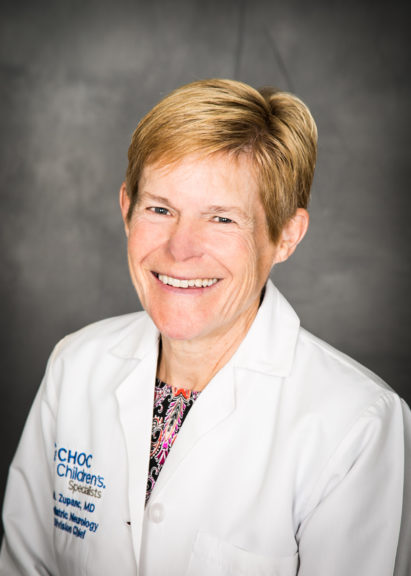Seizures can bring up a lot of worries and unknowns, especially when it comes to children.
One percent of the population has epilepsy, which puts the estimated number of children with epilepsy in Orange County alone at about 7,500. It is estimated that one in five people will have a seizure at some point—whether it develops into epilepsy or not—making seizures a more common neurological condition than multiple sclerosis, Parkinson’s and Alzheimer’s disease combined.
There are many common misconceptions about seizures, even within the medical community. Dr. Mary Zupanc, pediatric neurologist and epileptologist and co-medical director of CHOC’s Neuroscience Institute, points to five important points pediatricians should consider when seeing a patient who has had one or more seizures.
- There should be zero tolerance for seizures.
Seizures are considered epilepsy when a child has had two or more unprovoked seizures—seizures that are not tied to a different underlying condition.
When epilepsy is diagnosed, treatment should be initiated early. Some families are reluctant to treat their child’s epilepsy, often fearful that antiepileptic medication is worse than epilepsy itself. They worry about the side effects — that it will cause their child to have cognitive impairments and slow them down. However, repeated seizures can translate into progressive injury to the brain, with a decline in cognitive abilities and frequent psychosocial co-morbidities, including anxiety and depression. Furthermore, even if seizures are infrequent, there is a loss of independence for children and adolescents. An example would be an adolescent’s inability to obtain his/her driver’s license. - Epilepsy is progressive.
“Brain cells that seizure together network together,” Dr. Zupanc says, forming neuronal circuitry that hardwires the brain for continued seizures. Over time, there can be brain cell loss, cognitive decline, and important psychosocial consequences. Furthermore, when seizures continue, there is increased risk among those with epilepsy of sudden, unexpected death or other progressive neurological issues over the subsequent 20-30 years. - Encourage parents to act quickly.
Recurrent unprovoked seizures is the definition of epilepsy. Epilepsy should be treated and not ignored, for the reasons outlined above. Approximately 60-70% of epilepsy can be completely controlled with antiepileptic medication. Thirty percent of patients with epilepsy have intractable seizures, i.e. a failure to control the seizures with antiepileptic medications. These patients require more comprehensive care, including an evaluation for epilepsy surgery — at a Level IV Epilepsy Center, which is a designated center given only to those centers who provide multidisciplinary care with cutting-edge technology. Some parents fear that epilepsy surgery will cause serious neurological deficits. Most epilepsy surgeries are highly successful without detrimental effects to cognitive or motor functions. With epilepsy surgery, the risk of a severe and permanent injury is under 1%, and the risk of a minor or temporary injury is under 5%. Compared to the risks associated with years of recurrent seizures, the risks of epilepsy surgery are much lower than the risks of continued epilepsy.
The effectiveness of epilepsy surgery decreases significantly over time, especially for children who have had epilepsy for seven or more years. In addition, the plasticity of younger brains allows a transfer of functions to other parts of the brain — something adult brains cannot do as readily, Dr. Zupanc says.
Because of this, she strongly encourages epilepsy surgery early, not waiting until a child is older. - Delay in seizure treatment affects long-term psychological health.
The psycho-social components of seizures are oftentimes just as important as the physiological ones, says Dr. Zupanc. Depression and anxiety occur in 50- to 60% of children with epilepsy, and there is also a notable increase in suicidal risk.
These effects are increased when families wait to pursue recommended surgery, she says. Later in life, the surgery may remove the seizures, but the psychological effects are already deeply embedded. - Seizure history should affect your referral choice.
“It is so important for pediatricians to know that if a child’s epilepsy has not come under complete control after trying two or more antiepileptic medications, he/she should be referred to a higher level of epilepsy care, specifically a Level III-IV Epilepsy Center, as designated by the National Association of Epilepsy Centers,” says Dr. Zupanc. If the child is a young baby, the referral is even more urgent. “If a baby continues to have seizures after just one drug, he/she needs a referral to a Level III-IV epilepsy center immediately.”
The care plan should include pediatric epilepsy specialists, epilepsy-trained neurosurgeons, state of the art neuroimaging tools, nurse practitioners, pharmacists, dieticians, social workers and neuropsychologists.
“At CHOC, we treat epilepsy with a multidisciplinary team approach,” says Dr. Zupanc. Additional diagnostic tests are usually necessary to diagnose the appropriate epilepsy syndrome, determine if epilepsy surgery is an option, and/or outline an individualized, optimal treatment plan.
Furthermore, all of those involved in the child’s care hold a comprehensive epilepsy conference to discuss complex cases and lay out the best possible strategy for achieving a seizure-free outcome.





